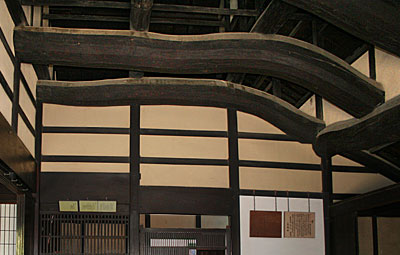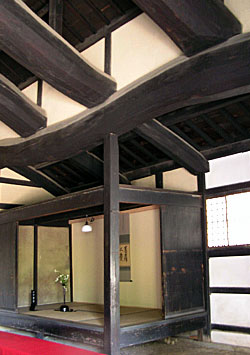|
||
 |
||


Nagatomi ix house (Hyougo)
@
(C)2001 Japanese Architecture and Art Net Users System.@No reproduction or republication without written permission.
fÚÌeLXgEÊ^ECXgÈÇASÄÌRec̳f¡»E]ÚðֶܷB
|
||||||
| @ | ||||||
| chounabari@çáÀ | ||||||
| KEY WORD :@architecture / folk dwellings | ||||||
| @ | ||||||
| Transverse roof beams that span the distance from the center posts of a vernacular house with a thatched roof to the *kawabashira ¤ or *geyabashira º® along the sides of the building. The beams are large in cross-section and straight for most of their length but bend sharply downward at the peripheral zone of the building *geya º®. The shape of the beam is thought to look like an adze *chouna çá, hence the name chounabari. The main purlin *jouyageta ã® is supported by the chounabari, allowing the mainframe posts *jouyabashira ã® to be dispensed with and avoiding the need for inconvenient supports. This vertical economy, however, requires a doubling of the horizontal plane because the chounabari do not support the *sasu ³ñ directly. Instead jouyageta and other longitudinal members that lie on the chounabari support the main transverse beam *jouyabari ã®À. The carpenters *daiku åH of the period made imaginative use of the twisted trunks growing on the steep mountain slopes near the structure, allowing roof loads to be transferred to the lower geyabashira and the elimination of the jouyabashira . Chounabari were usually disposed symmetrically in the parts of the building where they were used. They became a popular stylistic feature doubtless because of their impressive appearance. Also referred to as teppou SC (gun), because of a perceived resemblance to a gun. | ||||||
| @ | ||||||
  Nagatomi ix house (Hyougo) |
||||||
@ |
||||||
| REFERENCES: | ||||||
| *chouna-zukuri çᢠ| ||||||
| EXTERNAL LINKS: | ||||||
| @@ | ||||||
| NOTES: | ||||||
| @ | ||||||
(C)2001 Japanese Architecture and Art Net Users System.@No reproduction or republication without written permission. fÚÌeLXgEÊ^ECXgÈÇASÄÌRec̳f¡»E]ÚðֶܷB |
||||||
| @ |